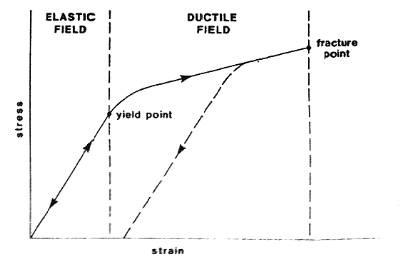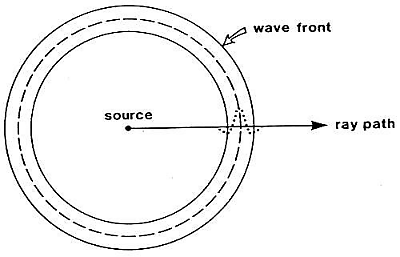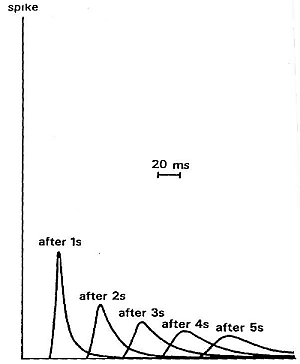
 |
Fundamental physics for seismology |
|
If we strike the earth with a hammer, an explosive charge, or an earthquake, the material of the earth near the source becomes compressed (or extended) and twisted. Earth materials are elastic and these deformations propagate away from the source. The speed of propagation and the type of motion propagated depends upon the elastic properties of the material, namely
By knowing the time at which the source occurred, and by measuring the travel time that it takes for the various waves to arrive at a receiver, it is possible to obtain information about the velocity and density of the material. This information is then used to provide information about structure and rock type. Applications of seismic surveying
When an external force is applied to a body, there are balanced internal forces set up within the body. Stress is a measure of these internal forces. Units are "force per unit area" or N/m2. There are two types of stress: |
Stress can be normal to the surface it is applied on, and hence compressive or tensile (top figures). |
 |
| Stress can be parallel to the surface. This is shear stress (bottom figure). |  shear shear |
 If a body is stressed it will undergo a change in size and shape. The body is strained. If the strains are small then the body will recover its original shape when the stress is removed. This is elastic strain. If the strain is too great so that the yield strength is exceeded, then the body deforms plastically and may ultimately fracture. Plastic strain is not recoverable.
If a body is stressed it will undergo a change in size and shape. The body is strained. If the strains are small then the body will recover its original shape when the stress is removed. This is elastic strain. If the strain is too great so that the yield strength is exceeded, then the body deforms plastically and may ultimately fracture. Plastic strain is not recoverable.
The figure plots how strain (horizontal axis) accumulates as stress (vertical axis) is applied. While behaviour is elastic, increasing or decreasing the stress does nothing to change the material. Once stress is sufficiant to make material behave platically, reducing the stress rsults in reduced strain along a different path on the graph. Once the fracture point is reached, the strain is released by breaking.
The linear relationship between stress and strain is known as Hooke's Law and is specified by five elastic moduli or elastic constants which express the ratio of a particular stress to a resultant strain. Four important constants are explained briefly next. Elastic constants are defined in Wikedia, and in the Schlumberger "Oilfield Glossary".
Consider a rod (figure right) of length l, cross-sectional area A, to which a uniform force F is applied to each end (a tensional force in this case): |
 |
Consider an initial volume V which is subjected to a hydrostatic pressure (force per unit area is the same in each direction). Let The bulk modulus is |
 |
If we apply a force parallel to a surface the force per unit area is known as the shear stress |
 |
Earth materials are elastic. The easiest way to obtain intuition is to think about rocks as being made up of a set of connected springs. Apply a force (stress) to any part and you will eventually get motion elsewhere. There are two general types of waves that can travel in the elastic material.
Specific types of waves within these general types are described below. Each wave type travels with a velocity that depends upon the elastic properties. |
 |
Compressional waves (P waves) propagate by compression and |
 |
Shear waves (S waves) propagate by a pure shear strain perpendicular to the wave propagation. |
 |
Note that if ![]() = 0 then Vs = 0. This tells us that shear waves do not travel in a liquid.
= 0 then Vs = 0. This tells us that shear waves do not travel in a liquid.
Seismic reflection and refraction surveying is usually carried out by observing how P-waves travel, reflect, and refract within the geologic layers near the surface. We will see that the energy is generated by an artificial source. S-waves can also be used, but they are a little harder to generate artificially (compared to P-waves), and require special ground motion sensors. However, since Vs < Vp, there are situations where it is beneficial to use S-waves instead of P-waves.
Rayleigh waves propagate along a free surface or on the boundary between two materials. Particle motion is a retrograde ellipse, and in the same plane as wave energy propagation. The amplitude of particle motion decays exponentially with depth. Rayleigh wave speed VR < VS. Large earthquakes can generate Rayleigh waves that circumnavigate the globe. This provides information about the velocity structure in the upper few hundred kilometers of the earth. |
 |
Love waves exist in a surface layer when the shear wave velocity of the upper layer is less than the shear wave velocity of the lower layer. The waves are trapped in the upper layer and the particle motion is parallel to the free surface and perpendicular to the direction of propagation.
|
 |
Both Love waves and Rayleigh waves are dispersive. That is, different frequency components travel at different speeds. So the wave changes shape as it travels. Also, the dispersion can be used to provide information about the velocity structure in the upper region of the earth. For shallow work, it is possible to generate surface waves artificially, and then observe the waves at a series of locations at increasing distances from the source. This type of field work is sometimes called multi-channel analysis of surface waves or MASW. This is usually considered an "advanced" topic in applied geophysics.
A wavefront indicates the locations at which the phase of the wave has the same value. For example, visualize the peaks (or troughs) of water ripples after a rock has been thrown in. The direction of propagation of the energy is normal to the wavefront. Seismic rays are imaginary lines perpendicular to the wavefront that indicate the path along which the wavefront is travelling. Rays are not physical entities. They exist only to illustrate where the energy travels. If you are connected to the internet, a good introduction, including Java animations, can be found within the notes for seismic surveying at the Colorado School of Mines on-line geophysics course. See the contents for there chapter, or start on the section on Wave Types. |
 |
|
Wave Velocity and Particle VelocitySeismic waves typically travel in the ground at 2-7 km/s. This is the velocity at which the energy moves, not the particles themselves. For comparison, sound travels in air at approximately 0.33 km/s. The wave energy can be recorded many kilometers from the source even if the source is small. The velocity and displacements of individual particles in the rocks are however very small; typical particle speeds are 10-8 m/s and typical ground displacements are 10-10 m. P-wave velocity of earth materialsSome characteristics of P-wave velocities are:
|
Vp (km/s) |
AttenuationThe amplitude of seismic waves falls off with distance from the source. There are two primary reasons:
The figure here shows the progressive change of shape of an original spike pulse during its propagation through the ground due to the effects of absorption (After Anstey 1977.) The spike's shape changes as well as experiencing reduced amplited. This is because the different frequencies making up the pulse decay at different rates - in fact, higher frequencies decay more rapidely than lower frequencies. This is easily observed on earthquake signals that have been recorded at different locations. As noted above in the context of surface waves, such frequency dependent behaviour is called dispersion. |
 |